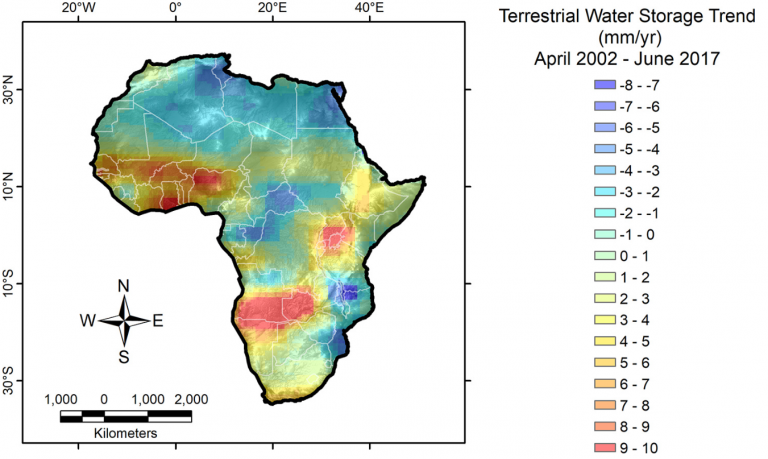A recent study finds that Africa’s freshwater storages are driven by natural variability.
Image: ScienceDirect
Hat-tip: Mary Brown
The authors examined GRACE satellite data and also found that Central Africa’s water storages are partially controlled by deforestation, and in northern Africa are controlled by groundwater extraction.
What follows is the paper’s abstract, which does not mention anthropogenic climate change:
The freshwater resources in Africa are vulnerable to natural variabilities as well as anthropogenic interventions. In this study, temporal (April 2002–June 2017) Gravity Recovery and Climate Experiment (GRACE) data are integrated, in a geographic information system environment, with rainfall, temperature, evapotranspiration, and altimetry remote sensing datasets to monitor the short-term trends in terrestrial water storage (TWS) over the African hydrogeologic systems and to explore their origins. Results show that short-term trends over the African continent are largely driven by natural variability such as changes in rainfall, evapotranspiration, and associated variations in lake levels. Exceptions to this observation include central Africa, where deforestation is found to additionally drive changes in TWS, as well as northern Africa, where TWS changes are dominated by anthropogenic groundwater extraction from fossil aquifers. Findings highlight the need for integrative responses at local, national, regional, and international levels by the African nations to overcome current and future challenges related to freshwater availability in Africa.”






If you want to discover how cloud seeding works, or if it works at all, do it over the Sahara. If there are any clouds, seed them, terraform the Sahara. Oases connected one after another in a chain of oases. Pump that fossil water that is fifteen thousand feet deep. Water has to be the number one limiting factor in the Sahara, sunshine is not unlimited, but almost. Temperature is not a problem, just water.
One acre of land is 43,560 square feet, 16.5 x 2640. One foot of water, rain, on one acre of land will be 43,560 cubic feet of water. One cubic foot of water is 7.48 gallons. Times the number of square feet in an acre of land, you’ll have 325,828.80 gallons of water in the form of rain on each acre of land. During the growing season, when it all happens, you’ll have your cake and eat it too.
12 inches of rain will be the amount of water you will need to grow a crop of corn, wheat, barley, what have you, in any 90 day period of time, a few more days, not much more. Not that big of a deal to receive that much moisture in three months time providing the soil is not desert dry and at least 50 percent saturated, you’ll have your 150 bushel corn with a 27 inch seasonal rainfall total.
If you want to have freeze-dried corn, don’t harvest it in the fall, let it sit all winter long and combine it in the spring when the ground is still hard from winter freeze. It is done, it works.
If you want a Green New Deal, terraform the Sahara and the Gobi deserts and you’ll have your Green Utopia.
There are hundreds of hectares of greenhouses in Spain to supply the European community with something to eat.
Transform the Sahara into a greenhouse cornucopia, just add water, and the African continent will benefit.
What is lost in Amazon forest can be regained in the Sahara.
Can’t really have more problems when there are solutions.
One solution is to ground Al Gore’s private jet. He can’t fly unless somebody says so, like Donald Trump. lol
[…] Africa’s Shortterm Freshwater Trends Largely Driven By Natural Variability […]